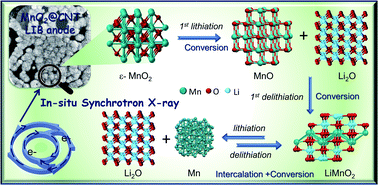High rate hybrid MnO2@CNT fabric anodes for Li-ion batteries: properties and a lithium storage mechanism study by in situ synchrotron X-ray scattering†
Abstract
High-performance anodes for rechargeable Li-ion batteries are produced by nanostructuring of transition metal oxides on a conductive support. Here, we demonstrate a hybrid material of MnO2 directly grown onto fabrics of carbon nanotube fibres, which exhibits notable specific capacities over 1100 and 500 mA h g−1 at discharge current densities of 25 mA g−1 and 5 A g−1, respectively, with a coulombic efficiency of 97.5%. Combined with 97% capacity retention after 1500 cycles at a current density of 5 A g−1, both capacity and stability are significantly above literature data. Detailed investigations involving electrochemical and in situ synchrotron X-ray scattering studies reveal that during galvanostatic cycling, MnO2 undergoes an irreversible phase transition to LiMnO2, which stores lithium through an intercalation process, followed by a conversion mechanism and pseudocapacitive processes. This mechanism is further confirmed by Raman spectroscopy and X-ray photoelectron spectroscopy. The fraction of pseudocapacitive charge storage ranges from 27% to 83%, for current densities from 25 mA g−1 to 5 A g−1. The firm attachment of the active material to the built-in current collector makes the electrodes flexible and mechanically robust, and ensures that the low charge transfer resistance and the high electrode surface area remain after irreversible phase transition of the active material and extensive cycling.



 Please wait while we load your content...
Please wait while we load your content...